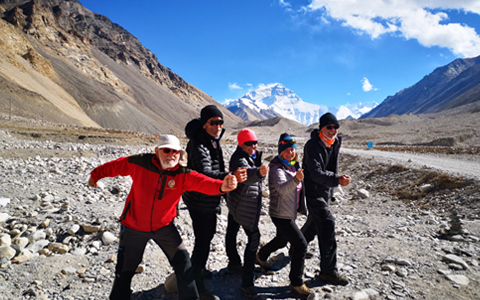Getting from Xi’an to Tibet is easy and straightforward, with two main options. You can take a direct flight and arrive in just about three hours. Or, you can enjoy a scenic train ride along the famous Qinghai-Tibet Railway.
In this guide, we will cover everything you need to know about traveling from Xi’an to Tibet. Read to know different travel options and required documents to prepare yourself a smooth and hassle-free trip!
How Far is Xi’an from Tibet? Why Travel to Tibet via Xi’an?
Xi’an, the capital of Shaanxi Province, is located in central China, while Lhasa, the capital of Tibet Autonomous Region, lies on the Tibetan Plateau in southwest China. The direct airline distance between them is about 1,400 kilometers, while the journey is around 2,800 to 3,000 kilometers by road and 2,860 kilometers by train.
Many tourists choose Xi’an as the gateway to Tibet primarily because of its convenient transportation. Xi’an is well connected to major cities across mainland China, including Beijing and Shanghai, as well as many international destinations. From Xi’an, you can choose between flights and trains to reach Tibet.
Also, Xi’an itself is a fascinating destination, especially for those curious about Chinese culture and history. As the ancient capital of 13 dynasties, it is home to the world-famous Terracotta Warriors, the Ancient City Wall, and the Muslim Center. You can have an enriching exploration here before venturing to the plateau.
 Xi'an city is a great gateway to Tibet.
Xi'an city is a great gateway to Tibet.Join our popular Tibet everest base camp tour for a smooth experience!
Option 1: Xi’an to Tibet by Flight - The Fastest and Most Convenient Way
The first option of taking a flight is one that many would prefer, as it is the quickest way to reach Tibet, taking just a few hours. Currently, Xi’an offers non-stop flights not only to Lhasa but also to Nyingchi and Shigatse.
Flights from Xi’an to Lhasa are the most convenient, with up to seven departures per day. Operated by Sichuan Airlines, Tibet Airlines, and China Eastern, these flights take only about 3 hours to reach Lhasa Gonggar Airport. A one-way economic ticket costs between $85 to $190 per person, depending on the season.
On the other hand, flights from Xi’an to Nyingchi are more expensive, starting at $150 per person, due to their low frequency of just 1 to 2 flights per day. Flights to Shigatse are even less frequent, only available on Tuesdays, Thursdays, Saturdays and Sundays. Both routes take around 3 to 3.5 hours for a non-stop journey.
| Route | Duration | Frequency | Price |
|---|
| Xi’an to Lhasa |
3h 10m |
7 flights per day |
From $85 |
| Xi’an to Nyingchi |
3h |
1-2 flights per day |
From $150 |
| Xi’an to Shigatse |
3h 30m |
1-2 flights on Tues, Thur, Sat, Sun |
From $115 |
 The flight from Xian to Lhasa is the quickest option.
The flight from Xian to Lhasa is the quickest option.Option 2: Xi’an to Tibet by Train - A Scenic Journey along Qinghai-Tibet Railway
Another good option is to take a train from Xi’an to Lhasa, although there is no direct train that starts from Xi’an. Instead, the trains from Xi’an to Lhasa originate from Guangzhou and Shanghai, and stop as they pass through the city. Therefore, there are two trains from Xi’an to Lhasa every day at present.
Covering a journey of about 30 hours, the train from Xi’an to Lhasa departs at 7:53 am and 9:27 am from Xi’an Railway Station. You will spend one night onboard before arriving in Lhasa in the afternoon of the following day. A hard sleeper berth costs around $84, while a soft sleeper berth costs around $134.
The major advantage of taking the Tibet trains from Xi’an is the breathtaking scenery that you will enjoy along the Qinghai-Tibet railway, the highest railway in the world. The train also offer a comfortable travel experience, with air conditioning and oxygen supply.
One thing to note is that Tibet train tickets to Lhasa are always in high demand. So it is best to book well in advance, to secure a ticket for your preferred date and seat. For a smooth journey, we can guarantee a soft sleeper ticket for you as long as you book your Tibet tour with us.
| Train No. | Dep./Arr. | Duration | Hard Sleeper Price | Soft Sleeper Price |
|---|
| Z265 Xi'an-Lhasa |
07:53 / 14:17 |
30h 24m |
$84 |
$134 |
| Z165 Xi'an-Lhasa |
09:27 / 15:05 |
29h 38m |
$85 |
$134 |
 Xi'an to Lhasa train offes a scenic journey along Qinghai-Tibet Railway.
Xi'an to Lhasa train offes a scenic journey along Qinghai-Tibet Railway.Join our classic Tibet small group tours with all-inclusive services!
Option 3: Fly to Xining and Then Take Tibet Train to Lhasa - An Enriching Route
If you are interested in the scenic Tibet train journey but prefer a shorter time onboard, you can first fly from Xi’an to Xining and then take the train to Lhasa. The train from Xining to Lhasa is the shortest of all Tibet train routes and offers the most frequent departures. It also covers all the highlights of the breathtaking Qinghai-Tibet Railway.
Flights from Xi’an to Xining are convenient, with six to seven departures each day and a flight time of only about 90 minutes. A one-way economy ticket costs between $40 and $110. You will arrive at Xining Caojiabao Airport, which is located 28 kilometers from downtown and 31 kilometers from Xining Railway Station.
From Xining, there are seven trains bound for Lhasa every day, as all other trains pass through and stop here. The journey takes about 21 hours, including one overnight stay onboard. A hard sleeper berth costs about $68 and a soft sleeper berth costs around $107.
An added advantage of this route is that you can stay in Xining for a day or two to help acclimatize to the altitude better. At an altitude of 2,275 meters, Xining is high enough to start your acclimatization to the higher altitudes of Lhasa, and help to reduce the risk of altitude sickness.
 Train from Xining to Lhasa passes stunning landscapes including Tanggula Mountains.
Train from Xining to Lhasa passes stunning landscapes including Tanggula Mountains.What Travel Documents are Needed for Traveling from Xi’an to Tibet?
No matter which route you choose to travel from Xi’an to Tibet, you need to first obtain a Chinese Visa and a Tibet Travel Permit. The Chinese Visa is obtained in your home country. However, if you are from one of those countries eligible for visa-free entry to China, you will only need the Tibet Travel Permit.
The Tibet Travel Permit is a must for all international tourists entering Tibet. While it can not be obtained through individual application, we can help you to get it in a simple process. Simply send us copies of your passport and Chinese Visa, and then we will handle the rest procedures.
Besides, if you are going to visit Mount Everest or Mount Kailash when touring Tibet, you will need additional permits, such as Aliens’ Travel Permit and Military Permit. No worries! We will take care of all these Tibet travel documents on your behalf, as long as you book your tour with us.
We guarantee your Tibet travel documents once you book your tour with us!
Conclusion
Traveling to Tibet from Xi’an can mainly be done in two ways: by Tibet train or by flight. The Tibet train from Xi’an to Lhasa takes about 30 hours and offers stunning landscapes along the way. While if you choose the flight, you will only need about several hours for a quick journey.
You can also take advantage of both flights and trains, by first flying to Xining and then taking the train to Lhasa. No matter which option you choose, you can surely enjoy a memorable journey. If you still have any questions, feel free to contact us or book your tour with us today!

























 Xi'an city is a great gateway to Tibet.
Xi'an city is a great gateway to Tibet.
 The flight from Xian to Lhasa is the quickest option.
The flight from Xian to Lhasa is the quickest option. Xi'an to Lhasa train offes a scenic journey along Qinghai-Tibet Railway.
Xi'an to Lhasa train offes a scenic journey along Qinghai-Tibet Railway. Train from Xining to Lhasa passes stunning landscapes including Tanggula Mountains.
Train from Xining to Lhasa passes stunning landscapes including Tanggula Mountains.









Ask a Quick Question